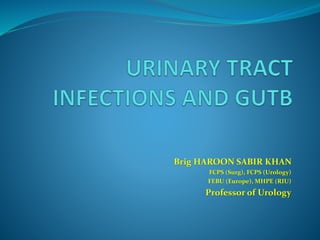
UTI 4th year Lecture.pptx
- 1. Brig HAROON SABIR KHAN FCPS (Surg), FCPS (Urology) FEBU (Europe), MHPE (RIU) Professor of Urology
- 2. Objectives By the end of this presentation students will be able to List upper and lower urinary tract parts Define Urinary tract infections Explain pathophysiology of UTI List the various factors responsible for UTI Diagnose UTI Manage Urinary tract infection
- 3. Urinary Tract Infection When bacteria invades Urinary tract and multiply. Bacteriuria: Presence of bacteria in urine (symptomatic/asymptomatic) Pyuria: presence of WBC in urine Uncomplicated/Complicated First infection Recurrent infection Unresolved Persistance Re-infection
- 4. Prevalence Women are more prone to UTI due to short urethra and anatomical position. Almost half of all women will have at least one episode of UTI. Risk of UTI in women increases after menopause. After a attack of UTI: 20-40 % will have a recurrence. Recurrent infections are usually reinfections.
- 6. Urinary Tract Infection- Types Pyelonephritis Intrarenal abscess Pararenal abscess Cystitis Prostatitis Urethritis Upper Lower
- 7. Bacteria NON-SPECIFIC E-Coli Enterobacter Proteus Klebsiella Pseudomonas Streptococcus fecalis Staphylococcus aureus Staphylococcus epidedimidis SPECIFIC Mycobacterium tuberculosis (GUTB) Neisseria gonorrhoeae (Gonorrhoea) Teponema pallidum (Syphillis) Trichomonas vaginalis (Trichomoniasis) Trematode (Schistimiasis ) Echionococcus granulosis (Hydatid cyst) Candida albicans (Fungal infection) Gram positive cocci Gram negative rods
- 11. Pathophysiology Routs of Infection Ascending Descending Iatrogenic Hematogenous Lymphogenous Extension from neighboring organs
- 14. Pathophysiology Uncomplicated UTI occurs in patients who have a normal unobstructed urinary tract, most commom in young, sexually active women Complicated UTI a. patient is a child or a pregnant woman b. Presence of structural or functional deformity or obstruction c. Underlying disease (diabetes, CKD, immunocompromised pt.) d. Recent instrumentation or surgery of urinary tract
- 15. Clinical Manifestations Emphysematous Pyelonephritis associated with production of gas in renal and perinephric tissue specially in diabetics. Xanthogranulomatus Pyelonephritis suppurative destruction of renal tissue from chroni urinary obstruction ( staghorn calculus) or with chronic obstruction. • Fournier’s Gangrene Acute fulminant necrotizing fasciitis or gangrene affecting external genitalia or perineum
- 18. Classification Acute Pyelonephritis Chronic Pyelonephritis Xanthogranulomatus Pyelonephritis Emphysematous Pyelonephritis Pyonephrosis and perinephric abscess Cystitis acute/chronic Acute urethral syndrome Epididymitis and orchitis Per urethral abscess Prostatitis/Prostatic abscess Fournier’s Gangrene
- 20. Investigations Urine R/E Urine C/S CBC RFTs Ultrasound Plain X-Ray KUB CT Scan plain/contrast enhanced IVU MCUG Isotope Scan (DTPA, DMSA, MAG-3)
- 21. Urine Collection Clean-catch mid stream urine sample Foleys catheterization Suprapubic puncture sample If sexually transmitted disease is suspected, a urethral swab is obtained prior to voiding In suspected urethritis in males, first few ml of urine sample is collected
- 23. Management UTI in men and non-pregnant women 7 to 14 days course of Quinolones or TMP-SMX 12 to 16 weeks course of treatment required In STD single dose Inj. Cephalosporin followed by oral antibiotics (Quinolone/ Cephalosporin/ Doxycycline) UTI in pregnancy Ampicillin, cephalosporin and nitrofurantion are considered relatively safe
- 24. Management Complicated UTI Therapy to be individualized according to culture result Treat the cause Asymptomatic Bacteriuria to be treated in Pregnant women Patients with neurogenic bladder Persons undergoing urologic surgery Renal transplant recipients
- 25. Management Catheter associated UTI Change/ remove catheter 7 to 14 days of antibiotics according to culture report Xanthogranulomatus pyelonephritis Nephrectomy Emphysematous pyelonephritis Early percutaneous nephrostomy followed by elective nephrectomy
- 26. Complications Recurrent UTI Permanent Kidney damage Low birth weight or premature infants Stricture urethra/ureter Infertility Sepsis/abscess Shrunken urinary bladder
- 28. Genitourinary Tuberculosis Specific infection of Urogenital system. Mycobacterium tuberculosis is the main causative organism. Almost secondary from pulmonary TB. Mainly Hematogenous spread. Kidney and prostate are primary organs involved, other organs involved by secondary seeding.
- 31. Clinical Features Hematuria gross/ microscopic Sterile Pyuria Flank pain LUTS Epididymo-orchitis Hydrocele Discharging scrotal sinuses Infertility Low grade fever/ weight loss Menstrual irregularities
- 32. Investigations Urine R/E Urine C/S Urine for AFB (ZN Staining) Urine culture for AFB CBC PCR Ultrasound CT Scan (contrast enhanced) Cystoscopy/ biopsy
- 37. Pathogenesis
- 42. Management Medical treatment Anti tubercular treatment (EHRZ, SHRZ) (Rifampicin, Isoniazid, Ethambutol, Pyrazinamide, Streptomycin) Surgical treatment I&D curettage and ATT Removal of organ Reconstruction surgery